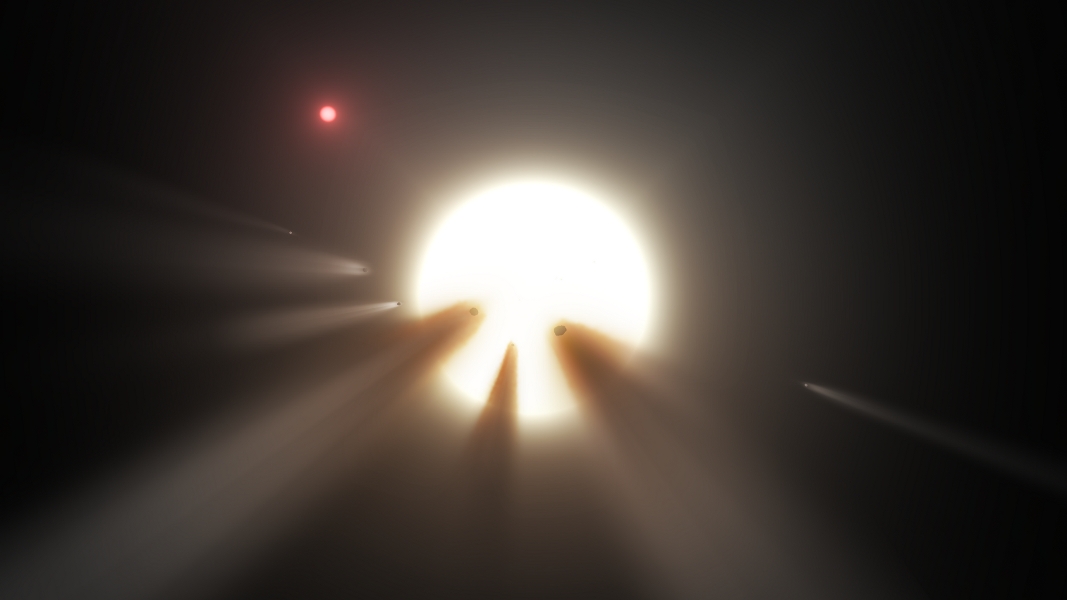Alien Megastructure? Kickstarter Campaign Launched to Study 'Tabby's Star'

The mystery of whether a darkening star is home to an alien megastructure might be solved with the aid of crowdfunding, researchers said.
Last fall, a star named KIC 8462852 made news when volunteers from the Planet Hunters citizen-science program uncovered something odd about the object's light. This discovery was made using data from NASA's Kepler space telescope (so far, Kepler has helped scientists find more than 2,200 alien planets.)
KIC 8462852 is an otherwise-ordinary F-type star, slightly larger and hotter than Earth's sun. It sits about 1,480 light-years away from Earth, in the constellation Cygnus. However, astronomer Tabetha "Tabby" Boyajian of Yale University in Connecticut and her colleagues found dozens of strange instances of the star dimming by up to 22 percent. [13 Ways to Hunt Intelligent Alien Life]
Since these events are far too substantial to be caused by planets crossing the star's face, researchers dubbed KIC 8462852 "the most mysterious star in our galaxy."
These analyses of the star — now nicknamed "Tabby's Star," or the WTF star for "Where's the Flux?" — raised the possibility that scientists had detected signs of intelligent alien life. Specifically, researchers have suggested that KIC 8462852 is home to a Dyson sphere, a hypothetical megastructure built around a star to capture as much of the sun's energy as possible. This energy would then be used to power an advanced civilization, it is proposed. (Science fiction often depicts Dyson spheres — which are named after mathematician and physicist Freeman Dyson — as solid shells around stars, but the structures could also be globular swarms of giant solar panels.)
There is still no widely accepted answer as to why Tabby's Star behaves so strangely. "Comets are currently the best natural explanation," Boyajian told Space.com. "That said, 'best' does not necessarily mean 'good.'"
Unfortunately, Kepler has moved on to a different mission and can no longer observe KIC 8462852 in an attempt to unlock the star's confounding secrets.
Get the Space.com Newsletter
Breaking space news, the latest updates on rocket launches, skywatching events and more!
"It's exciting when you realize that you are working on something new and unusual, but also, at the same time, extremely frustrating," Boyajian said.
To keep working on the mystery of Tabby's Star, and hopefully ease some of that frustration, Boyajian and her colleagues are now turning to crowdfunding. They said they hope a Kickstarter campaign will help raise at least $100,000 by June 17 to secure observing time on a global network of ground-based telescopes. That way, researchers can see when the star's brightness dips again, the investigators said.
The scientists are currently observing Tabby's Star using the Las Cumbres Observatory Global Telescope Network (LCOGT), a privately run network specifically designed to continuously monitor objects in space. Although this network does not have Kepler's precision, it will be sensitive enough to detect fluctuations in the star's brightness, researchers said.
So far, the network has gifted the researchers with 200 hours to begin the project, which will take them to the end of the summer. The new Kickstarter campaign may help cover the expenses of monitoring this star for a year, including a total of 2 hours per night dedicated to observing the star.
The scientists said they are turning to private observatories because government-run sites do not have the capabilities for the long-term, continuous monitoring this project needs. The traditional way to pay for private observatories is through a government grant, but the researchers said that more than five-sixths of grant applications for time on such facilities are turned down. And the proposals that do get accepted are usually relatively "safe" ones that promise certain and immediate returns, the researchers said; that's why the team is now turning to crowdfunding.
The researchers warned that patience will likely be needed, even if this project gets funded. When Kepler was observing KIC 8462852, after all, the star fluctuated in brightness only 5 percent of the time, and at unpredictable times.
Still, "this project is the ultimate opportunity to help discover something new," Boyajian said.
You can learn more about the Kickstarter campaign here:
https://www.kickstarter.com/projects/608159144/the-most-mysterious-star-in-the-galaxy
Follow Charles Q. Choi on Twitter @cqchoi. Follow us @Spacedotcom, Facebook and Google+. Original article on Space.com.
Join our Space Forums to keep talking space on the latest missions, night sky and more! And if you have a news tip, correction or comment, let us know at: community@space.com.

Charles Q. Choi is a contributing writer for Space.com and Live Science. He covers all things human origins and astronomy as well as physics, animals and general science topics. Charles has a Master of Arts degree from the University of Missouri-Columbia, School of Journalism and a Bachelor of Arts degree from the University of South Florida. Charles has visited every continent on Earth, drinking rancid yak butter tea in Lhasa, snorkeling with sea lions in the Galapagos and even climbing an iceberg in Antarctica. Visit him at http://www.sciwriter.us